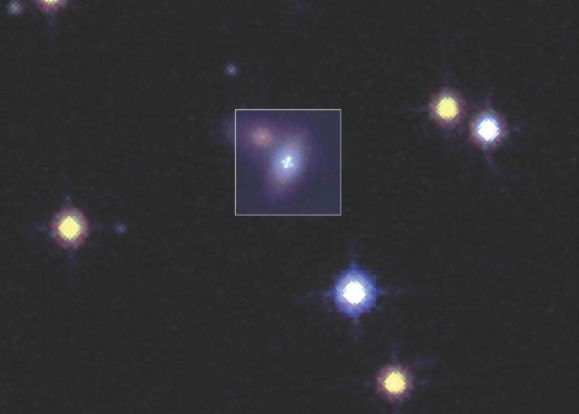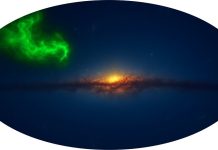
In a groundbreaking discovery, scientists have found a supernova explosion called “SN Zwicky” using an extraordinary phenomenon known as gravitational lensing.
This phenomenon occurs when massive objects, such as galaxies, bend light as it travels through space and time, acting like cosmic magnifying glasses.
By observing the resulting visual distortions caused by the lensing effect, astronomers can study objects that would otherwise be too distant and faint to observe.
SN Zwicky, located over 4 billion light years away, was magnified nearly 25 times by a foreground galaxy acting as a lens.
This rare find presents a unique opportunity for scientists to delve into the inner workings of galaxies, explore dark matter, and gain insights into the mechanics behind the expansion of our universe.
The findings, published in the journal Nature Astronomy, provide a comprehensive analysis, spectroscopic data, and imaging of SN Zwicky.
The discovery of SN Zwicky not only demonstrates the incredible capabilities of modern astronomical instruments but also marks a significant step forward in our quest to comprehend the fundamental forces shaping our universe, as noted by the paper’s lead author, Ariel Goobar, director of the Oskar Klein Center at Stockholm University.
Initially detected at the Zwicky Transient Facility (ZTF), SN Zwicky caught scientists’ attention due to its unusual brightness.
Using cutting-edge instruments such as the W.M. Keck Observatory, the Very Large Telescopes, and NASA’s Hubble Space Telescope, the research team observed four images of SN Zwicky from different positions in the sky.
They confirmed that gravitational lensing was responsible for the supernova’s remarkable radiance.
According to Igor Andreoni, a postdoctoral associate in UMD’s Department of Astronomy and NASA’s Goddard Space Flight Center, supernovae like SN Zwicky play a crucial role in helping scientists measure cosmic distances.
Supernovae like SN Zwicky belong to a class known as “standard candles” because their well-known luminosities allow scientists to determine distances in space.
By comparing the brightness of two light sources, researchers can independently calculate distance without directly studying the galaxy itself.
SN Zwicky not only serves as a useful tool to measure cosmic distances but also presents new avenues for exploring galaxies’ properties, including the enigmatic dark matter that constitutes the majority of matter in the universe.
Scientists believe that lensed supernovae like SN Zwicky hold promise in studying dark energy—a mysterious force that counteracts gravity and drives the accelerated expansion of the universe.
They also aid in refining current models, including calculating the Hubble constant, which describes the rate at which the universe is expanding.
The discovery and analysis of SN Zwicky represent just the beginning for Andreoni and his team.
The forthcoming Vera Rubin Observatory in Chile, scheduled to begin full operations in 2024, will build upon their findings. Equipped with advanced technology, the observatory will capture multiple images of the entire visible sky, enabling the search for other supernovae and asteroids.
Andreoni believes that the team’s “big picture” approach, which led to the identification and analysis of SN Zwicky, will continue to help scientists gather vast amounts of data about celestial events.
This discovery opens doors to finding more rare lensed supernovae in future surveys, aiding in the study of transient astronomical events like supernovae and gamma-ray bursts.
By surveying the sky extensively and without specific targets, astronomers hope to explore the transient sky with unparalleled depth.
In summary, the remarkable discovery of SN Zwicky through gravitational lensing offers high school students a glimpse into the captivating world of astronomy.
It highlights the powerful tools and techniques used by astronomers to unlock the secrets of the universe and inspires further exploration to unravel the mysteries that lie beyond our reach.



